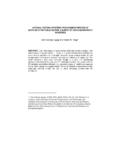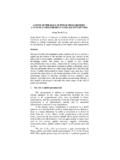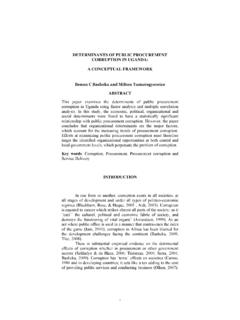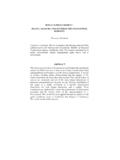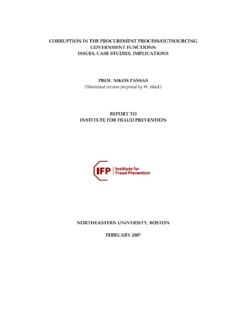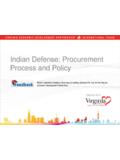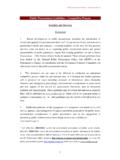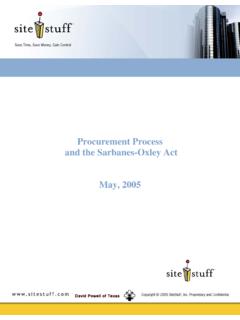Transcription of A CASE STUDY ON THE PROCUREMENT PROCESS …
1 A CASE STUDY ON THE PROCUREMENT PROCESS development IN THE PUBLIC ENTERPRISE THROUGH ERP ADOPTION Jeongwook Khang and Yungmok Yu Jeongwook Khang is a senior researcher, Center for Gas Economics and Management, Korea Gas Corporation. He has a master degree at Industrial Engineering and now in doctorial course at Production and Operations Management. His research interests are in public energy-enterprises, and service tangibilization. Yungmok Yu is a professor, Management department, Dankook Univ. Korea ABSTRACT Enterprise Resource Planning (ERP) system, which is recognized as a useful tool in the view of enterprise PROCESS integration, has pursued automated transactions, efficiency of operational decision making, productivity and development of customer service.
2 In 2000s, it is a trend that ERP system adoptions in the public-sector organizations is gaining acceptance. The features of the recent trend in public enterprises are related that the goal of public enterprises are mainly based 'cost minimization' rather than 'profit maximization'. In this STUDY , a public enterprise which has adopted ERP systems recently and is now in the phase of stabilization, is selected and a case STUDY is made about the success factors in ERP system adoption PROCESS and the PROCUREMENT PROCESS development in the public enterprise. INTRODUCTION Enterprise Resource Planning (ERP) system has been recognized as a useful tool in the view of enterprise PROCESS integration mainly in the manufacturing fields since 1990s.
3 Based in the development of IT and business reengineering, ERP system has been spotlighted as one of the most powerful tool among methodologies which set up and actualize enterprise future vision in the aspects of establish enterprise-wide management innovation. Enterprises which introduce ERP system expect automated transactions, high efficiency in decision making and productivity, and high market performance through advanced customer services. The objective of ERP system introduction eventually could fall into the secure and keeping the company s competitive advantage.
4 Garcia-Sanchez and Perez-Bernal (2007) defined ERP systems as an information system that combine organizational functions and distribute shared benefits to all departments. Business risks drive from the models, artifacts, and processes that are chosen and adopted as a part of implementation and are generated from the firm s portfolio with respect to their internal consistency and their external match with business partners. Organizational risks derive from the environment including personnel and organizational structure in which the system is chosen and implemented (Daniel E.)
5 O Leary, 2000). In 1990s, ERP adoptions focused on the integration of the various inner-processes and operations systems of the enterprise. Moving into 2000 s, the focus of ERP adoption expanded its range including CRM (Custom Relationship Management) and SCM (Supply Chain Management) related value chain, and pursued more advanced integration. The business fields which are introduced ERP system also widened from earlier manufacturing to service and public sectors. Due to the features connected with the transparency of company, even tax benefit was introduced to encourage the ERP adopters.
6 But the general ERP adoption by public enterprises still limited. It resulted from that the objective of public enterprises focus to cost minimization compared with the private company s profit maximization . However ERP system has many benefits, implementation of ERP is still considered wide, time consuming PROCESS with high cost. The cost of ERP system adoption is not only for IT software but consulting, education and previous system integration. Although ERP system cause largely high cost, the satisfaction of the result performance of ERP adoption relatively has not been so high.
7 As there are many companies which adopt ERP system, ERP adoption could be no longer the sufficient conditions of gaining the company s competitive advantage because ERP systems become a one of IT solution-commodities. The earlier research about ERP system is largely limited with finding the critical success factor and the successful implementation while ERP introduction proceed as planned. Recently, the importance of maintenance and expansion of the given ERP system stand out. Although some studied about defining business PROCESS requirements for large-scale public sector ERP implementations (George Blick et al), researches which are related with the public enterprise who adopted ERP system and its successful usage are still limited.
8 In this STUDY , a public enterprise which has adopted ERP systems recently and is now in the phase of stabilization, is selected and a case STUDY is made about the success factors in ERP system adoption PROCESS and the PROCUREMENT PROCESS development in the public enterprise. LITERATURE REVIEW In public sector markets, federal, state, and local ERP systems evolved due to advancements in the commercial sector in the 1980s. Specifically, independent financial systems were augmented to include those functions required to manage the "business of government," where constituents replaced the consumer in the value chain and accounting and budgeting were required to account for tax revenue expenditures.
9 Bearing Point points that the success factors of ERP adoption in public sectors are categorized into nine elements, which are the senior executive s strident sponsorship before proceeding; business transformation project, not an IT project; the most talented business manager in the organization as project manager; to decide issues quickly and decisively; communication among relatives; robust infrastructure before implementing an ERP solution; not changing the ERP source code; sufficient test of the given ERP software; to plan user training and assign sufficient resources to this activity; and to set reasonable user and executive expectations (2003).
10 Pansoo Lee argues in the STUDY of finding the effects of introduction characteristics of ERP system on the performance of public enterprise that consentaneity and complexity; publicity and education; easiness and comprehension are significant statistically. In general, the will of CEO is the most important factor in adopt of the ERP system or for the improvement of performance. But in public enterprise, the enough publicity and education for use of ERP system are the most important factors in adopt of the ERP system. The public enterprise has to educate system user highly and professionally for using and understanding of ERP system.
